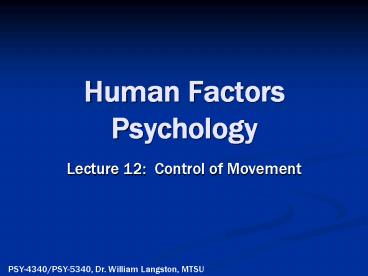Human Factors Psychology - PowerPoint PPT Presentation
1 / 16
Title:
Human Factors Psychology
Description:
Human Factors Psychology. Lecture 12: Control of Movement ... When the action is slow. In some situations feedback can be fast enough to correct movements. ... – PowerPoint PPT presentation
Number of Views:160
Avg rating:3.0/5.0
Title: Human Factors Psychology
1
Human Factors Psychology
- Lecture 12 Control of Movement
PSY-4340/PSY-5340, Dr. William Langston, MTSU
2
Control of Movement
- Two parts
- Physiological component Muscle, skeleton,
tendons, etc. - Psychological Neurons, brain, etc.
3
Physiological Foundations of Movement
- Degrees of freedom
- Forearm from elbow has one.
- Shoulder has three.
- Degrees of freedom problem How is a smooth
trajectory chosen from the infinite combination
of degrees of freedom? Sources of constraint - Biomechanical (range of motion).
- Higher level (cerebellum).
4
Control of Movement
- Motor unit One motor neuron plus its connected
muscle fibers. - Can range from 100-1,000 fibers per neuron.
- Innervation ratio influences precision of
movement. - Eye muscles low ratio.
- Lower leg muscles high ratio.
- Fatigue Requiring prolonged, strong muscle
contraction causes fatigue. - The greater the strength thats needed, the
shorter the time it can be applied. - Physical supports can eliminate some sources of
fatigue.
5
Control of Action
- Continuous vs. discrete
- Discrete Has clear beginning and end (throwing
a ball). - Continuous No clear end (driving).
- Open vs. closed skills
- Open skills Dynamic environment,
environmentally paced. - Closed Static environment, self-paced.
6
Control of Action
- Open-loop vs. closed-loop control
- Closed-loop Influenced by feedback.
Refinements based on vision, proprioception, etc. - Open-loop Develop motor program and execute.
- Tasks can be faster than sensory feedback can
keep up (skilled typing). - More complex tasks take longer to program.
- Somewhat effector independent (writing your name
on the board is pretty similar to writing it on
paper switching hands less independent). - Can be influenced by feedback
- To select program.
- When the action is slow.
- In some situations feedback can be fast enough to
correct movements.
7
Aimed Movements
- Have to go to a particular target location (e.g.,
push a button). Influenced by - Effector chosen.
- Distance.
- Presence of visual feedback.
8
Aimed Movements
- Fitts Law A kind of speed-accuracy trade-off
in aimed movements. - Index of difficulty
- I log2 2D
- W
- D Center to center distance between targets.
- W Width of targets.
9
Aimed Movements
- Fitts Law
- Movement time
- MT a b(I)
- a Base time.
- b Channel capacity.
- When the distance required for movement is
doubled, time will not change if width of target
is also doubled. Applies to a lot of domains - Putting washers on pegs.
- Controlling a cursor with a joystick.
- Using tweezers under a microscope.
10
Aimed Movements
- Fitts Law
- Implication The slope can be an index of
performance difficulty. For example, having to
reach above your shoulders in an assembly task
increases the slope compared to tasks below
shoulder height.
11
Aimed Movements
- Visual feedback
- Depending on the task, it can operate in as
little as 140 ms, or 190-260 ms. - Implication Even rapid movements can benefit
from the presence of visual feedback. - Bimanual control Something for each hand.
- Easier and harder movements are coupled.
12
Grasping and Intercepting Objects
- Grasping Two phases
- Transport (kind of like an aimed movement).
- Slower than an aimed movement (have to grasp at
the end). - Affected by the goal of the action.
- Grasp phase.
- Tau Inverse of the rate of dilation of an
object on the retina (time-to-contact). - In simulated driving, estimates of
time-to-contact with moving and stationary
targets are based on tau. - In real driving, other variables also come into
play.
13
Movement Sequences
- Trying to go at the maximum rate
- Some skills are limited by the rate at which
repetitive movements can be made (e.g., writing). - For maintaining timing between successive
responses - Slower rate has more variability.
- Interresponse times for successive responses are
negatively correlated (a long one will be
followed by a short one).
14
And the Rest
- Posture Partially controlled by vision. If you
move the walls, people will lean. - Locomotion Walking.
- Eye and head movements Primarily to get the
fovea fixated on the target. - Speech production Special case, but controlled
by similar variables. Speech sound air
voicing place manner.
15
Summary
- If people have to move to make a response, its a
good idea to consider properties governing
movement when setting up the task.
16
Human Factors Psychology
- Lecture 12 Control of Movement
- End
- References
- The notes are based on Proctor, R. W., van
Zandt, T. (1994). Human factors in simple and
complex systems. Boston Allyn and Bacon.































